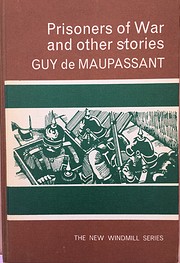I found this slim volume wedged unobtrusively between Somerset Maugham and Michael Morpurgo in my sitting room fiction section. And I had no idea it was there. It’s an ex-library copy in the New Windmill series 1969, reprinted in 1975. So there’s an introduction by the redoubtable Ian Seraillier. It’s stamped with the name of the Kent school I taught in from 1985-93.
Well, I’m not a book thief so how did I acquire it? As Head of English, I had overall responsibility for the library which meant that I line-managed the teacher in direct charge of it. One day we invited in the County School Library Adviser, at our Head’s suggestion because he was a friend of hers. He told us to get rid of all the old stock and found us a little grant to buy snazzy red and blue chairs. So the librarian was soon putting out lots of trays of redundant free-to-a-good-home books. And, thinking back now, that must have been how Guy de Maupassant came home with me. At the time, for the record, several of us thought that the whole library update project was an act of cultural vandalism and I was uneasy about condoning it but “updating” and “refreshing” were the buzzwords.
The eighteen stories in this volume (translated by HNP Sloman) came from three volumes published by Penguin in 1946, 1951 and 1955. In fact Maupassant (1850-1893) wrote over 300 stories in his short life. I know “The Necklace” very well because it features it lots of school anthologies and I’ve shared it with many classes but the rest were virgin territory for me until now. And the first thing that strikes me is just how gripping they are.
Maupassant was conscripted into the Franco Prussian war in 1870 and that experience informs the title story and several others. “Prisoners of War” is about a French girl who managed to trick some Prussian soldiers into imprisonment in the cellar under the family farm.
Several of the stories are about love and relationships. “The Question of Latin” for example gives us a dull teacher of Latin who, with a bit of benign skulduggery from a pupil, is joyfully manoeuvred into a passionate marriage. It’s spry and witty.
Meanness is another theme. Maupassant was born in Dieppe and tells us repeatedly that Norman people are a miserly, self-interested lot. Don’t shoot me for stereotyping. I’m simply sharing Maupassant’s oft-stated view. Madame Oreille, however, in “The Umbrella” doesn’t get the comeuppance she deserves when she tries to claim a miniscule amount on the household insurance for a damaged parapluie.
I liked “The Wreck” too in which an insurance assessor gets dangerously stuck on a wrecked ship with an English family to whose eldest daughter he takes a shine.
Maupassant is very good at denouements. Perhaps the parrot doesn’t deserve to die at the end of “The Drowned Man” but. My goodness, he makes sure you sympathise with the perpetrator. Abusive relationships, incidentally, are clearly something which interests him and it isn’t always the men who are the bullies.

Something which made me feel slightly uneasy is the casual cruelty to animals: the dog starved as a way of training it for a revenge killing, the fish cooked alive, the St Bernard locked out to die in the snow. But I tell myself that I have to make allowances for two reasons and try not to wince. First the French (remember foie gras?) have never been quite to committed to animal welfare as the British, at least, try to be. Second, these stories were written over 150 years ago and attitudes change.
Next week on Susan’s Bookshelves: Standard Deviation by Katherine Heiny